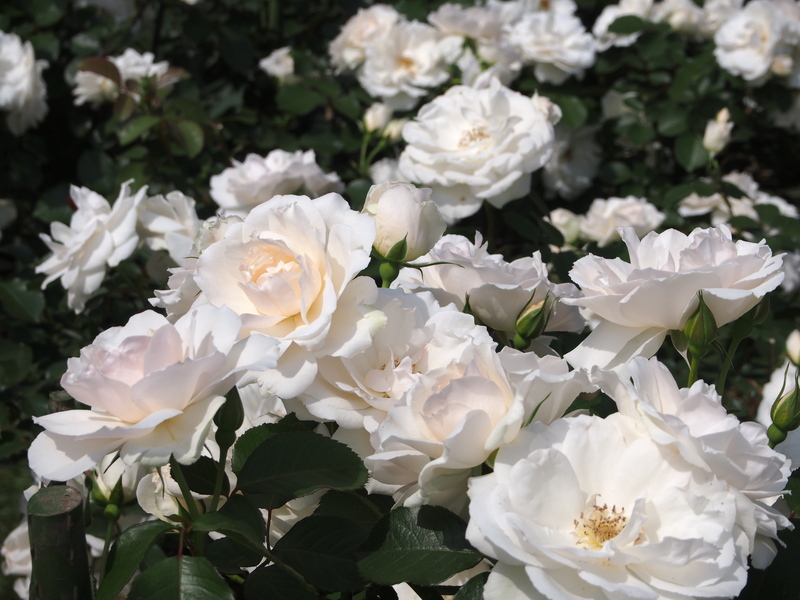Innovative Strategies to Shield Your Garden Plants in Winter
Posted on 09/06/2025
Innovative Strategies to Shield Your Garden Plants in Winter
As the temperature drops and frost settles in, every gardener faces the challenge of protecting their beloved garden plants from the harsh realities of winter. Shielding garden plants in winter does not have to mean boring traditional methods--there are a wealth of innovative strategies to keep your landscape not just surviving, but thriving, through the colder months. Whether you have a small backyard, sprawling landscape, or container garden, these winter plant protection techniques will help you nurture your green companions and prep for a spectacular spring bloom.

Understanding Winter Challenges for Garden Plants
Before implementing any winter plant shielding solutions, it's essential to understand the risks posed by the season. Cold temperatures, frost, chilling winds, moisture loss, and even hungry wildlife all play roles in weakening or killing vulnerable plants. Knowing these threats helps you craft a bespoke defense system for your garden.
Common Winter Hazards for Your Garden
- Frost and Freezing: Ice crystals can rupture plant cells and roots.
- Desiccation: Cold winds accelerate water loss from leaves and soil.
- Snow Weight: Heavy snowfall can break branches or flatten perennials.
- Temperature Fluctuations: Repeated freeze-thaw cycles stress plants.
- Rodent and Wildlife Damage: Scarce food sources push animals to nibble on your garden plants.
With these hazards in mind, let's explore innovative solutions to shield your garden plants in winter.
1. Advanced Mulching Techniques for Winter Protection
Mulch is a classic, but modern science and creativity have expanded its role beyond simply retaining soil warmth. Innovative mulching techniques provide both insulation and moisture control, acting as the first line of defense for winterizing garden plants.
- Layering Organic and Inorganic Mulch: Begin with a base of organic material like shredded leaves or straw, topped with an airy layer of pine needles or even recycled fabric. This hybrid approach maximizes insulation while allowing drainage, reducing the risk of rot.
- Living Mulches: Consider planting cold-tolerant ground covers (like clover or creeping thyme) among your beds in late summer. These living mulches add a natural protective barrier, prevent soil erosion, and can be trimmed back in spring.
- Seasonal Swapping: Replace summer mulch (like bark chips) with lighter, fluffier winter mulch in late fall to prevent heavy compaction under snow and ice, ensuring continued air flow around roots.
Pro Tip: Apply mulch after the ground has begun to freeze for best results. This prevents rodents from nesting beneath and keeps soil temperature more stable.
2. Modern Plant Cover Solutions
Gone are the days when a plastic sheet was your only cover option. Recent innovations have made protective covers for winter garden plants more effective and easier to use.
Types of Innovative Plant Covers
- Frost Cloths and Floating Row Covers: Lightweight, breathable fabrics trap heat while allowing moisture and light to reach plants, preventing mold or mildew build-up.
- Garden Cloches: These dome-shaped covers, now available in sturdy clear plastic, glass, or even recycled water bottles, create mini-greenhouses for prized plants or seedlings.
- Insulated Garden Blankets: Thicker than row covers, these are designed for extended cold snaps and provide substantial thermal insulation.
- Pop-up Greenhouses: Portable, collapsible greenhouses can be easily set up over raised beds or rows of delicate perennials, offering protection from the harshest elements.
Expert Advice: Always anchor covers securely to the ground with pegs or rocks to prevent wind lift. Remove covers periodically during mild spells to avoid overheating your plants.
3. Water Management: Hydrate Strategically Before the Freeze
It's easy to forget about plant hydration as winter arrives. However, soil moisture plays a key role in shielding garden plants during cold weather:
- Pre-Freeze Deep Watering: Water the garden thoroughly before the first hard frost. Moist soil holds heat better, protecting roots against sudden chills.
- Use Soaker Hoses Under Mulch: Strategically install hoses to provide slow, steady moisture throughout fall and winter thaws without waterlogging roots or freezing on top.
- Rain Barrels: Insulate outdoor barrels and use melted snow runoff on warmer days if dry conditions persist.
Tip: Don't overwater! Frozen, soggy soils can suffocate roots and foster rot. Always check moisture levels beneath mulch for best results.
4. Wind Breaks: Shielding Plants from Winter Winds
Cold winds can be even more damaging than low temperatures alone, stripping moisture and chilling plants to the core. Incorporate innovative windbreak strategies into your garden design:
- Living Walls: Plant dense evergreen shrubs (such as arborvitae, boxwood, or holly) on the windward side for a natural, year-round wind barrier.
- Temporary Screens: Erect reusable fabric screens, bamboo fencing, or even rows of hay bales around sensitive beds or exposed slopes.
- Snow Fencing: Specially designed mesh fencing not only slows the wind but also helps capture drifting snow, providing a protective layer of insulation for your garden beds.
Innovative Solution: Interweave vertical panels of recycled plastic or canvas between your raised beds to create customizable microclimates and shield garden plants during winter storms.
5. Smart Plant Selection and Placement
One of the most effective ways to protect your garden plants in winter is to plan ahead. Choose plant varieties and positions that naturally resist winter stress:
- Opt for Hardy Varieties: Select perennials, shrubs, and trees bred specifically for your USDA zone. Modern cultivars often boast improved cold-tolerance.
- Group Wisely: Cluster tender plants together so that you can protect them with a single cover or windbreak.
- Microclimate Mastery: Take advantage of natural landscape features--plant cold-sensitive species near the southern wall of your home or shed, where reflected heat and shelter give them an edge.
Remember: South-facing slopes warm more quickly in Spring, giving early bloomers a head start, while low-lying depressions can trap cold air ("frost pockets") and should be avoided for delicate specimens.
6. Unconventional Insulation Materials
Break away from tradition by experimenting with innovative insulation materials for winter plant protection:
- Bubble Wrap: This lightweight, moisture-resistant material can be wrapped around pots or outdoor planters for an extra layer of insulation. There are even specially designed horticultural bubble wraps available today!
- Row Tunnel Innovations: Use split PVC pipes and clear plastic sheeting to create flexible tunnel covers. These allow easy access for harvesting or ventilation on warmer days.
- Old Blankets and Rugs: Repurpose unwanted textiles to wrap around the base of larger shrubs or trunks for temporary frost protection.
- Compost Jackets: Create a perimeter of wire mesh around tender perennials and fill it with loose compost or shredded leaves for a nutrient-rich, biodegradable buffer that gradually feeds plants as it breaks down.
7. High-Tech Winter Plant Protection
Embrace the future of gardening with advanced winter shielding technologies:
- Soil Temperature Sensors: Smart sensors track real-time ground temperatures and send alerts when additional frost protection is necessary.
- Heated Plant Mats: These electric mats are designed for outdoor use and can be placed under pots or seed trays to keep roots from freezing.
- Remote-Controlled Row Covers: Modern innovations enable you to deploy or retract covers from your smartphone, optimizing protection based on daily forecasts.
Did You Know? Some advanced systems allow integration with weather apps, so your garden's protection is always one step ahead of the coming chill!
8. Wildlife Management: Keeping Hungry Animals at Bay
Winter scarcity drives deer, rabbits, mice, and even birds into your garden. Innovative deterrents keep your winter-shielded plants safe:
- Aromatic Barriers: Install mesh bags of strong-smelling herbs like mint, lavender, or rosemary, or use commercial animal repellents around prized beds.
- Motion-Activated Lights/Noise Makers: Solar-powered gadgets can scare away nocturnal visitors without constant human intervention.
- Strategic Netting: Lightweight netting can protect berries, buds, or evergreens with minimal visual impact.
- Garden Statues and Decoys: Moveable decoys (such as owl models or reflective tape) confuse animals and encourage them to forage elsewhere.
9. Container and Raised Bed Gardens: Special Solutions
If you have garden plants in containers or raised beds, they require extra attention, as roots are more exposed to temperature extremes.
- Moveable Shelter: When possible, relocate potted plants against insulating walls, under decks, or in sheltered corners to cut down on wind and cold exposure.
- Pot Grouping: Group containers closely together and wrap the entire assembly in bubble wrap, burlap, or horticultural fleece.
- Raised Bed Blanketing: Install hinged wooden frames with removable clear covers to easily insulate and ventilate as needed.
10. Ongoing Care and Monitoring
Even the best winter protection strategies for garden plants require regular monitoring. Check on your plants after storms, adjust coverings after temperature shifts, and watch for signs of wildlife incursions or mold. This vigilance will ensure your innovative efforts pay off come spring.

Conclusion: Winterizing Your Garden with a Creative Edge
With a blend of traditional wisdom and innovative winter shielding strategies, you can confidently safeguard your garden plants against even the harshest weather. From advanced covering materials and smart watering techniques to high-tech solutions and creative wildlife deterrents, today's gardeners have more tools than ever to keep landscapes lush and healthy year-round.
Gardeners who think outside the box and adapt to changing conditions will enjoy more robust plants, improved spring growth, and a truly resilient outdoor oasis. Invest in these innovative ways to protect your garden plants in winter and watch your garden come alive, season after season!
Frequently Asked Questions on Winter Garden Protection
- Q: Is it ever too late to shield plants for winter?
A: Protection is best applied before the first hard frost, but adding mulch or covers even after mild frost can still help safeguard roots and new growth. - Q: Which plants benefit most from winter protection?
A: Tender perennials, young shrubs, potted specimens, and anything marginally hardy in your zone will benefit most from your efforts. - Q: How do I know if my insulation is "too much"?
A: Check regularly for soggy or moldy conditions and ensure covers are breathable. Over-insulation can trap moisture and prevent airflow, harming plants more than helping.
By blending knowledge, technology, and creativity, you can master the art of winter garden plant protection--and set your green space up for year-round success.

